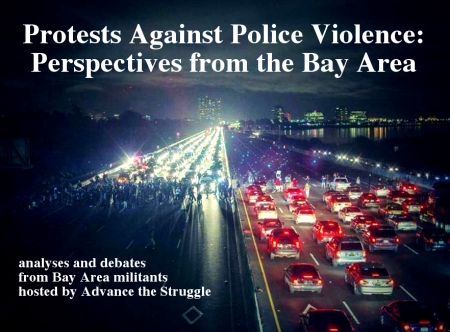All of us have been paying close attention to development of black insurgency over the past few years. The power of street protests, new black activist groups, and recent anti-racist demands at universities highlight the direction that the movement’s energy is going. Further, the recent spread of pro black, anti-racist demands at numerous universities following the Mizzou protests demonstrate one possible way in which the movement is cohering: through the development of common demands on college campuses.

Protesters block Interstate 580 in Oakland, Calif., on Monday, Nov. 24, 2014, after the announcement of the grand jury decision not to indict Ferguson police officer Darren Wilson in the fatal shooting of Michael Brown, an unarmed 18-year-old. (AP Photo/Noah Berger)
Oakland was an exciting place to be, again, during the hot winter weeks of late November and early December 2014. Protests raged nightly, and so many of us found ourselves marching together through the streets, evading cops, and blocking freeways and BART stations wherever was possible. Walking down Broadway, turning right on 7th street and heading toward the West Oakland BART station. Stopping midway and having debates about which direction to go – toward 980? Back toward the 880? Piedmont? The chaotic discussions we had brought that familiar feeling of ungovernability back to our lives. Our militant and disorderly activities were creative and generative to the extent that we got practice in challenging the infrastructure of Bay Area capitalism, attempting to block flows of traffic in ways that at least felt like we were disrupting flows of capital. Celebrating militancy is important, but perhaps more important is pointing out some of the limitations of our courageous actions.
There are three key limits that we want to highlight here.









 This interview from a brother who’s worked as a MUNI operator for more than ten years is one powerful and particular expression of how bosses exploit workers for profit, leaving us physically and psychologically maimed. It reveals how at the same time that passengers have seen fares double in recent years and the elimination of bus lines, the men and women behind the wheel are also feeling the effects of austerity. This operator’s experience reflects the daily lives of millions of other workers around the world who also face cuts to social services, racist police brutality, attacks on basic political freedoms under the scapegoat of “terrorism,” and an overall capitalist assault on the minds and bodies of working people. Nevertheless, where there is oppression, there is also resistance. We must take pride in and study the current militant struggles Palestinian and Egyptian transport workers wage with other workers in their countries to topple hated
This interview from a brother who’s worked as a MUNI operator for more than ten years is one powerful and particular expression of how bosses exploit workers for profit, leaving us physically and psychologically maimed. It reveals how at the same time that passengers have seen fares double in recent years and the elimination of bus lines, the men and women behind the wheel are also feeling the effects of austerity. This operator’s experience reflects the daily lives of millions of other workers around the world who also face cuts to social services, racist police brutality, attacks on basic political freedoms under the scapegoat of “terrorism,” and an overall capitalist assault on the minds and bodies of working people. Nevertheless, where there is oppression, there is also resistance. We must take pride in and study the current militant struggles Palestinian and Egyptian transport workers wage with other workers in their countries to topple hated school for elementary school aged kids. The difference with this picture is that the gardening activity is taking place at a school site, Lakeview elementary, that’s been taken over by parents, teachers, community members and radicals. On the last day of school, June 15th, this motley mix of people held a bbq that marked the end of the Oakland Unified School District’s 2011-2012 school year and marked the beginning of the transformation of the Lakeview elementary campus into the People’s School for Public Education. This initiative is led by a committee of activists, parents, and teachers that formed out of the struggle against school closures in the fall of 2011; this struggle was itself intimately bound up within the context of a general strike called for by Occupy Oakland one day after 5 elementary schools were announced to be closed by the OUSD. The purpose here is to document and explore some of the context behind this current struggle, the complexities and contradictions involved in its organizing, and thoughts on moving forward.
school for elementary school aged kids. The difference with this picture is that the gardening activity is taking place at a school site, Lakeview elementary, that’s been taken over by parents, teachers, community members and radicals. On the last day of school, June 15th, this motley mix of people held a bbq that marked the end of the Oakland Unified School District’s 2011-2012 school year and marked the beginning of the transformation of the Lakeview elementary campus into the People’s School for Public Education. This initiative is led by a committee of activists, parents, and teachers that formed out of the struggle against school closures in the fall of 2011; this struggle was itself intimately bound up within the context of a general strike called for by Occupy Oakland one day after 5 elementary schools were announced to be closed by the OUSD. The purpose here is to document and explore some of the context behind this current struggle, the complexities and contradictions involved in its organizing, and thoughts on moving forward.


You must be logged in to post a comment.